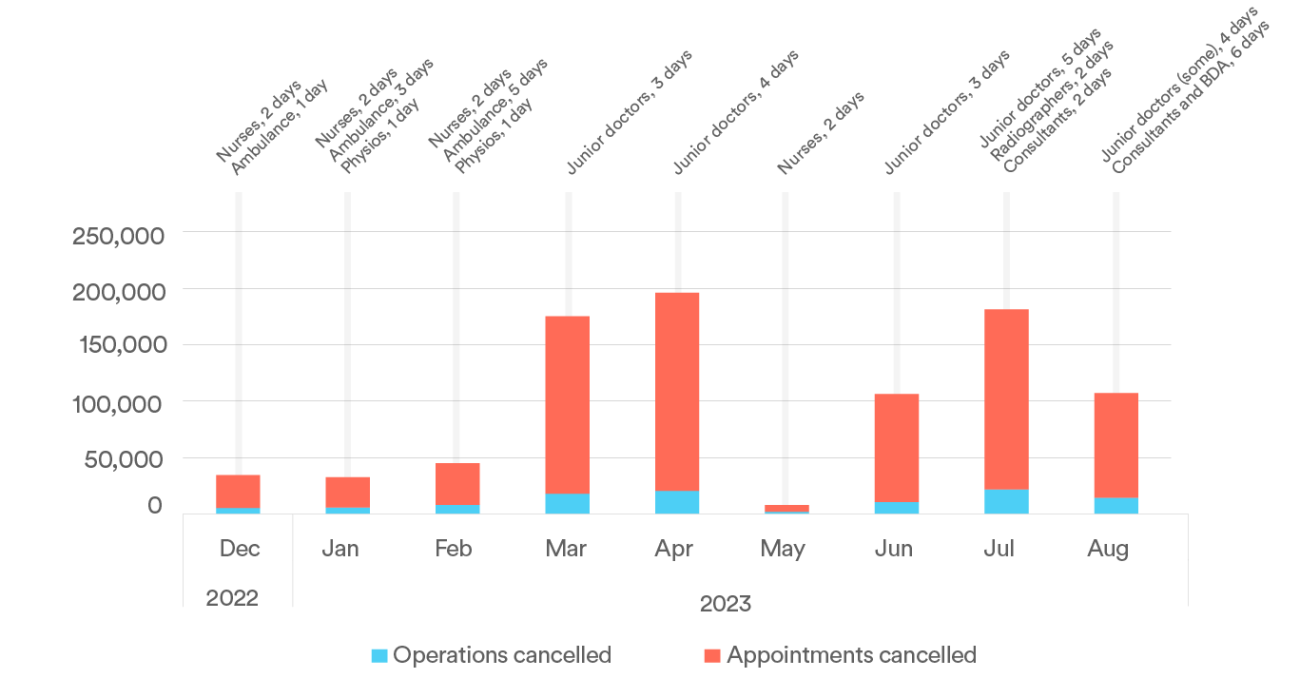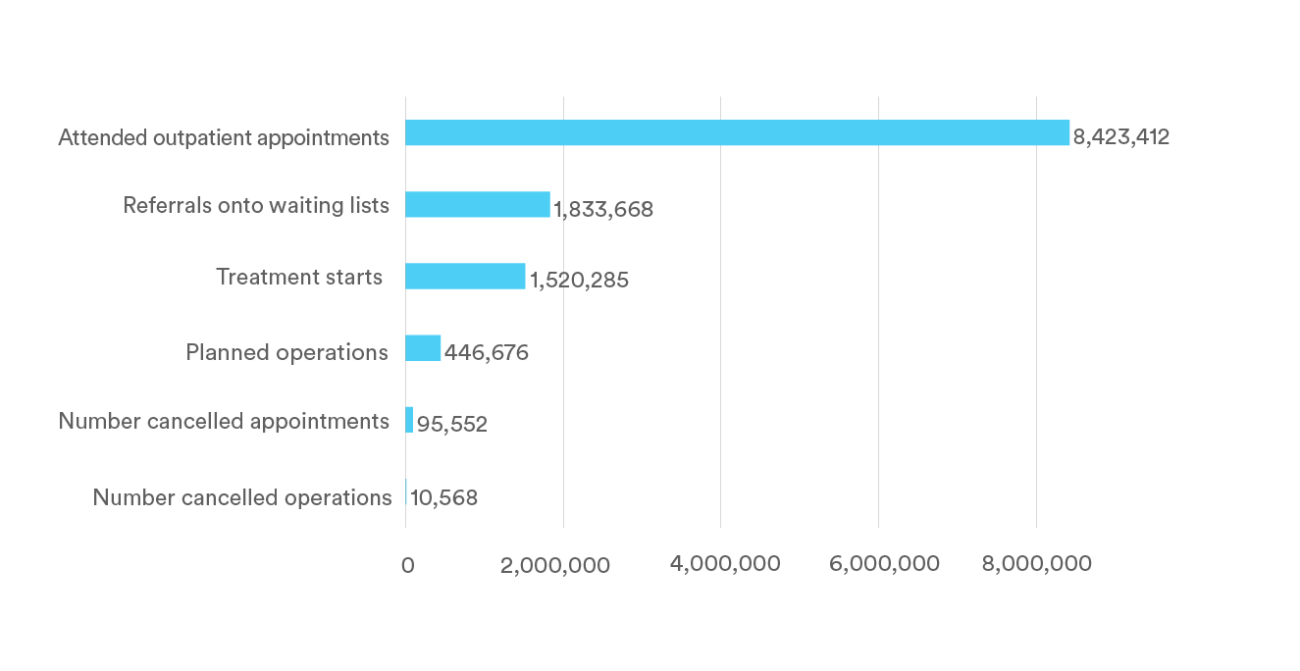The Prime Minister pledged in January this year that “NHS waiting lists will fall and people will get the care they need more quickly”. Prior to this, in February last year, NHS England set out how the NHS would recover planned hospital care to address lengthening waiting lists – which was already a problem before the pandemic but has been exacerbated by Covid-related disruption.
For waiting lists to fall, the NHS needs to not only increase the number of people treated, but to treat more people than are coming forward for care. It also needs not only to recover services to pre-pandemic levels, but to increase activity beyond those levels, as waiting lists were already rising in 2020. To add to this challenge, since last December there have been a series of well-documented strikes by NHS workers dissatisfied with pay and working conditions, including by ambulance staff, nurses, junior doctors and now consultants.
In this context, we unpick what we know, and don’t know, about the impact of the strikes on planned hospital care, and ultimately on the waiting list.
How much planned hospital care has been lost due to strikes?
Information collected from NHS hospitals and published by NHS England indicates that, as of the end of August, 104,881 operations and 780,273 outpatient appointments were rescheduled, over the 42 days of strikes since December last year. This is likely to be an underestimate of cancelled activity: information is missing for some hospitals for some strikes and, as the strikes have gone on, hospitals may also be booking less activity on known strike dates, to reduce the impact on patients from last-minute cancellations.
The number of appointments and planned operations cancelled was higher during doctors’ strikes which occurred in March and April, and from June onwards, relative to strikes by nurses or ambulance workers over the winter.
The volume of lost activity needs to be considered in the context of how many operations and appointments would typically take place in the NHS each day. The number of organisations and numbers of individuals striking has varied, and many operations and appointments did go ahead as planned, even on strike days. Some of the recent strikes have also been at the weekend, when few planned tests and operations would have been scheduled. We also need to remember that the number of appointments which take place is generally under 80% of all booked appointments, so not all of the cancelled appointments would have translated into actual activity.
Making a comparison with expected activity is complicated. One reason is that describing “typical” activity is difficult: planned activity has been significantly disrupted during Covid since March 2020, through to the most recent winter when emergency care was under intense pressure due to both Covid and flu. Planned activity also varies by day of the week, and comparisons need to take account of variation in the number of working days each month, and when bank holidays and weekends occur. Finally, information on actual activity is published two months in arrears, so data for August won’t be available until October.
In the charts below, we show actual operations and appointments per working day, along with the expected activity based on the same month in the pre-pandemic year (March 2019 to February 2020), and the potential activity which might have occurred had the strikes not happened.
The number of planned operations had not recovered to pre-pandemic levels prior to the strikes, whereas the numbers of attended outpatient appointments were similar to pre-pandemic levels. Relative to activity that actually took place, a greater proportion of operations were cancelled on strike days than has been the case for outpatient appointments. For example, in June there were 3,523 cancelled operations per strike day, compared with 20,303 operations per working day, indicating that approximately 15% of operations on strike days may have been cancelled. For outpatient appointments, there were 31,851 appointments cancelled per strike day, compared to 382,882 attended appointments – equating to 8% of activity on strike days. However, given most days in a month are not strike days, the overall impact on activity is small, with an estimated 2.3% of operations cancelled and 1.1% of appointments cancelled in June.
What is the impact on the waiting list?
The size of the waiting list, which reached almost 7.6 million in June, reflects the number of people joining the list, following a referral from their GP for example, and the number of people who leave the list, either when they start treatment or because of changes to their health. The waiting list has grown from 2.9 million over the last decade because more people are coming onto it than are starting treatment. Starting treatment could mean beginning a course of medication, or could be surgery.
Importantly, having an appointment or operation does not always mean the person will leave the waiting list. Patients often have more than one appointment before they receive a diagnosis and begin treatment, and can also have procedures in order to be diagnosed, such as an endoscopy. This means that the cancelled operations and appointments as a result of the strikes would not all have reduced the waiting list. Rather, it would have shifted the NHS back a step in dealing with a patient’s care.
The scale of people joining the waiting list, activity taking place and the number of cancellations for June 2023 are illustrated below. As discussed, the number of people joining and leaving the waiting list is much lower than the number of outpatient appointments because appointments can include multiple steps in a patient’s journey. The number of operations which took place is lower than the number of treatment starts, which also include patients starting medication as their treatment. The numbers of cancelled appointments and operations are even lower.
So how much are strikes to blame for the growing waiting list?
Both the government and NHS England are blaming the strikes for slowing the recovery of planned care. Based on the data available, it’s clear that there would have been more operations and appointments had the strikes not taken place. But it is unlikely that the lost activity would have been enough to enable waiting lists to come down, and it is certainly not the case that the strikes alone are to blame for continued long waits – given that the number of planned operations hadn’t yet recovered even to pre-pandemic levels before the strikes began.
The debate about whether the strikes can be blamed for the continued increase in the waiting list risks taking the focus away from the most important impact, which is on patients. People on the waiting list are bearing the brunt of the continuing industrial disputes, in terms of missed care, disruption to their lives, and anxiety about the long-term consequences. The challenge of ensuring cover for shifts, reorganising appointments and replanning clinics and operating theatre schedules impacts patients either side of strikes, as well as on the day.
The impact on patients is likely to be compounded if the strikes continue into the winter months, as now seems likely. While NHS organisations have worked hard to manage disruption and ensure emergency care provision, this will become even more challenging during winter months, when higher demand for urgent care and staff sickness will add to the challenge.
Data notes and sources
Number of cancelled appointments and operations has been compiled from NHS England data published here: https://www.england.nhs.uk/publication/preparedness-for-potential-industrial-action-in-the-nhs/#heading-3
Attended outpatient appointments: https://files.digital.nhs.uk/C3/15A720/HES_M3_2324_OPEN_DATA.csv
Expected activity is estimated to be the volume of activity in the equivalent month in the last pre-pandemic year (March 2019 to Feb 2020). For example, the expected activity for December 2022 has been estimated to be December 2019 actual activity.
Treatment starts and referrals onto the waiting lists obtained from NHS England Referrral to Treatment (RTT) data on clock stops (sum of admitted and non-admitted pathways) and new RTT periods: https://www.england.nhs.uk/statistics/statistical-work-areas/rtt-waiting-times/
Elective procedures extracted from Hospital Episode Statistics Admitted Patient Care data, grouped by month based on month of admission. See this report for further detail on inclusions and exclusions.
This work uses data provided by patients and collected by the NHS as part of their care and support. Read more on our website: https://www.nuffieldtrust.org.uk/about/how-we-are-run-1#informationsecurity-and-data. The analysis uses Hospital Episode Statistics (HES) data (year range 2016/17 to 2023/24). Copyright © 2023, NHS England. Re-used with permission of NHS Digital. All rights reserved. A data-sharing agreement with NHS England (DARS-NIC-226261-M2T0Q) governed access to and use of HES data for this work.
Suggested citation
Scobie S (2023) “Are strikes by health care staff impacting NHS waiting lists?”, Nuffield Trust blog


